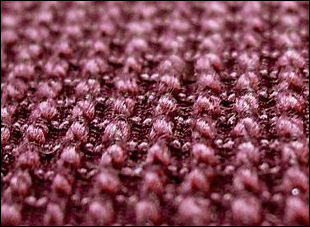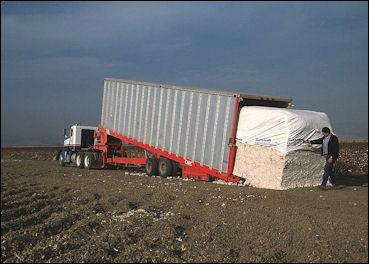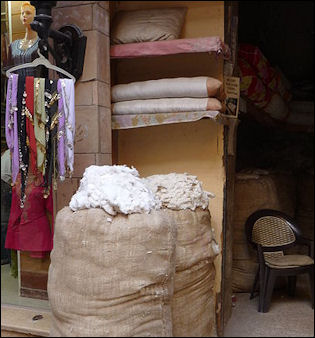COTTON

Cotton factory in Vietnam in 1987 Cotton is arguably the world's most important nonfood crop. It supplies about 80 percent of the world's natural fibers and continues to be primary material in half the world's textiles despite competition from synthetic fibers. Cotton is ideal fore making cloth because its fibers bond and interlock when spun into long strands that can be is easily dyed. [Source: Jon Thompson, National Geographic, June 1994**]
Cotton accounts for 40 percent of the fiber used today. About 20 million farmers in 80 countries produce 44 million metric tons of cotton a year.
Cotton was once called white gold. Developing the machinery to quickly make it into cloth was a driving force behind the Industrial Revolution. Providing labor to produce it for these machine was behind the slave economy in the southern United States and in turn and indirect cause of the American Civil War. Making money from it kept the colonial economies going in places like India and Egypt.
Cotton is used to make clothes, towels, sheets, rugs, draperies, cloth, batting, cellulose products, cordage, and sewing threads. It can also be ground into currency, crushed into vegetable oil, and woven into coffee filters, bookbindings, tents, diapers and fishnet. Fire men like cotton firehouses over polyester ones because they soak up enough water to keep them from melting. Environmentalists like it mops up oil spills better than almost any other material. And doctors like for bandages and sutures because of its durability under a lot of different conditions. **
Websites and Resources: Cotton Incorporated cottoninc.com ; National Cotton Council of America cotton.org ; Wikipedia article on Cotton wikipedia.org/wiki/Cotton ; Story of Cotton cottonsjourney.com ; Cotton Outlook cotlook.com ; Cotton Council International, Cotton USA cottonusa.org ; UNCTAD www.unctad.org/infocomm/anglais/cotton ; Plant Cultures plantcultures.org/plants/cotton ;
World’s Top Cotton Producing Countries
Seed Cotton refers to cotton harvested from the field prior to ginning. It is comprised of raw cotton and seeds. During ginning, cotton fiber is separated from the seed. The resulting raw cotton is called lint. Lint is made up of long fibers suitable for producing yarn. After the ginning process some small fibers are still attached to the seed. These are called linters.
Cotton is grown in more than 80 countries. In 1992 they produced a total of 83 million bales, or almost 40 billion pounds. The United States, China, India and the former Soviet Union have traditionally been the world’s largest producers. To achieve the status as the world's forth largest cotton producer the Soviet Union Russia drained water for irrigation from the rivers leading into the Aral Sea, causing the one-time sixth largest lake in the world to shrink to number four. In the early 2000s, China consumed 37 percent of the world’s cotton.
World’s Top Producers of Seed Cotton (2020): 1) China: 29500000 tonnes; 2) India: 17731050 tonnes; 3) United States: 9737277 tonnes; 4) Brazil: 7070136 tonnes; 5) Pakistan: 3454334 tonnes; 6) Uzbekistan: 3063998 tonnes; 7) Turkey: 1773646 tonnes; 8) Argentina: 1046043 tonnes; 9) Burkina Faso: 782925 tonnes; 10) Benin: 728000 tonnes; 11) Mexico: 674706 tonnes; 12) Turkmenistan: 636360 tonnes; 13) Cote d’Ivoire: 490442 tonnes; 14) Cameroon: 445808 tonnes; 15) Tajikistan: 401366 tonnes; 16) Australia: 372872 tonnes; 17) Azerbaijan: 336792 tonnes; 18) Kazakhstan: 326582 tonnes; 19) Sudan: 320553 tonnes; 20) Myanmar: 308953 tonnes [Source: FAOSTAT, Food and Agriculture Organization (U.N.), fao.org. A tonne (or metric ton) is a metric unit of mass equivalent to 1,000 kilograms (kgs) or 2,204.6 pounds (lbs). A ton is an imperial unit of mass equivalent to 1,016.047 kg or 2,240 lbs.]
cotton sofa cover World’s Top Producers (in terms of value) of Seed Cotton (2019): 1) China: Int.$21175158,000 ; 2) India: Int.$16711604,000 ; 3) United States: Int.$11671878,000 ; 4) Brazil: Int.$6210176,000 ; 5) Pakistan: Int.$4049204,000 ; 6) Uzbekistan: Int.$2427379,000 ; 7) Turkey: Int.$1981969,000 ; 8) Australia: Int.$1465812,000 ; 9) Mexico: Int.$826106,000 ; 10) Argentina: Int.$786230,000 ; 11) Benin: Int.$713386,000 ; 12) Burkina Faso: Int.$652457,000 ; 13) Mali: Int.$640294,000 ; 14) Turkmenistan: Int.$524321,000 ; 15) Tajikistan: Int.$363068,000 ; 16) Cote d’Ivoire: Int.$320710,000 ; 17) Kazakhstan: Int.$310236,000 ; 18) Chad: Int.$292791,000 ; 19) Cameroon: Int.$290506,000 ; 20) Egypt: Int.$274773,000 ; [An international dollar (Int.$) buys a comparable amount of goods in the cited country that a U.S. dollar would buy in the United States.]
World’s Top Producers of Cotton Lint (2019): 1) India: 6033470 tonnes; 2) China: 4891915 tonnes; 3) United States: 4335440 tonnes; 4) Brazil: 2688403 tonnes; 5) Pakistan: 1556052 tonnes; 6) Turkey: 814000 tonnes; 7) Uzbekistan: 769224 tonnes; 8) Australia: 414336 tonnes; 9) Mexico: 368000 tonnes; 10) Argentina: 307912 tonnes; 11) Benin: 300000 tonnes; 12) Mali: 295163 tonnes; 13) Burkina Faso: 247420 tonnes; 14) Côte d'Ivoire: 211500 tonnes; 15) Tanzania: 183796 tonnes; 16) Turkmenistan: 158296 tonnes; 17) Sudan: 149940 tonnes; 18) Cameroon: 140000 tonnes; 19) Tajikistan: 114897 tonnes; 20) Kazakhstan: 114000 tonnes
Top Cotton-Producing Countries in 2008: (Production, $1000, Production, metric tons, FAO): 1) China, 11133600 , 7500000; 2) India, 5621725 , 3787000; 3) United States of America, 4141996 , 2790200; 4) Pakistan, 2983804 , 2010000; 5) Brazil, 1953551 , 1315984; 6) Uzbekistan, 1820269 , 1226200; 7) Turkey, 999055 , 673000; 8) Greece, 430499 , 290000; 9) Turkmenistan, 415654 , 280000; 10) Syrian Arab Republic, 362213 , 244000; 11) Burkina Faso, 335492 , 226000; 12) Nigeria, 247908 , 167000; 13) Egypt, 237516 , 160000; 14) Argentina, 201889 , 136000; 15) Australia, 197138 , 132800; 16) Benin, 186005 , 125300; 17) Mexico, 185560 , 125000; 18) Tajikistan, 172941 , 116500; 19) Mozambique, 166606 , 112232; 20) Kazakhstan, 155870 , 105000;
Weaving and Cloth
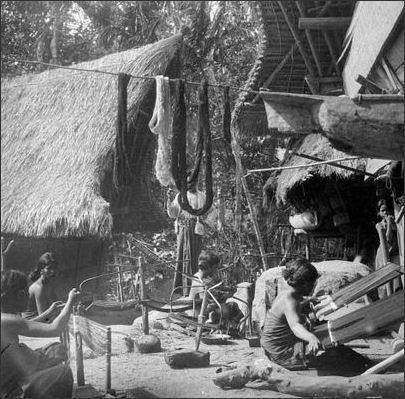
weaving in Sumatra Weaving is the interlocking at right angles of two sets of fibers to make cloth or a similar material. Spinning is the process by which fibers are drawn and twisted into string, yarn or thread. These tasks have traditionally been done at home by women with looms and spinning devices. The advantage with working at home is that women could work and care for their children at the same time and do weaving and spinning when they are not doing other chores.
To make yarn the old-fashion way: 1) fibers are cleaned and straightened by carding with a toothed card (a sort of brush with stiff bristles). 2) The fibers are then rolled between two cards to produce a thin fiber-like piece called a sliver. 3) The sliver is placed on a spike called a distaff. 4) A strand of wool is then pulled off and a weight known as whorl is attached to it. 5) The strand is twisted into a thread by spinning it with the thumb and forefinger. Since each thread is made this way, you can how time consuming it must have been to make a piece of cloth before machinery was widely used.
To make cloth the old-fashion way: 1) Threads are placed on a warp-weighted loom. Warps are the downward hanging threads on a loom, and they are set up so that every other thread faces forward and the others are in the back. 2) A weft (horizontal thread) is then taken in between the forward and backward row of warps. 3) Before the weft is threaded through in the other direction, the position of the warps is changed with something called a heddle rod. This simple tool reverses the warps so that the row in the front is now in the rear, and visa versa. In this way the threads are woven in a cross stitch manner that holds them together and creates cloth. The cloth in turn is all kinds of things. Cloth is often sold to clothing manufacturers in rolls. One roll of cloth is about 11 meters in length.
Sometimes natural dies are used. Red is made with madder or kermes (an insect found in kermes oak); yellow with wild chamomile, saffron, vine leaves and the rinds of pomegranates; black from acorns; and blue from plants with indigo. Natural dyes produce richer and more natural colors. The depth of color can be controlled by the type of water — rain, river or spring — used. Plant dyes though are notoriously unpredictable. They are affected by weather conditions, soil and when they are harvested. They have mostly been replaced by chemical dyes.
Early History of Cotton
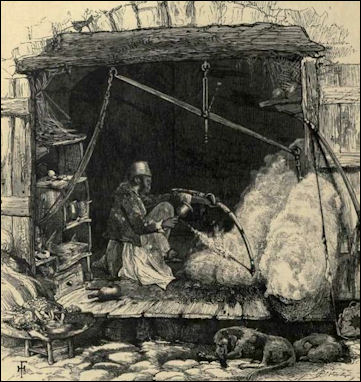
Jewish cotton seller
in Jerusalem in 1880 Cotton has been used as a fibre at least since 3000 B.C. in India and the Americas. Fragments of 4000-year-old cotton cloth have been found in Indus valley in Pakistan and in the coastal valleys of Peru. In ancient Peru mummies were wrapped in cotton while those from ancient Egypt were wrapped in linen. Even so samples of cotton have from ancient Egypt have also been found. Some scientists say that cotton has been cultivated for more than 7,000 years.
No one is quite sure where the cotton we use today originated from. Plants of different species similar to modern cotton plants were domesticated in India and Central and South America thousands of years ago.
Unlike silk which for centuries was produced only in Asia, cotton was produced all over the world. Soldiers in the army of Alexander the Great used it to pad their saddles. The Chinese developed cotton in ancient times but didn’t use it widely until the 13th century. When the Spanish arrived n the Americas in the 15th and 16th centuries they found that the Aztecs and Incas were skilled at spinning, weaving and dying cotton.
Cotton was not widely used in the making of cloth in Europe until the A.D. 15th century and even then weavers mostly combined it linen.. Raw cotton appeared in Italy in the 12th century. It was introduced from India by Arabs via Spain and Sicily and was called muslin after the cotton manufacturing town of Mosul in present-day Iraq. Clothing had traditionally been made most from wool and flax (linen), with silk being beyond the means of all but the rich.
Cotton from the Americas was superior to strains brought to Europe from the Middle East and India because its long strands (three inches in some case) were ideal for ideal for making smooth comfortable cloth. This cotton most likely was first cultivated in what is now Tabasco and Veracruz states in Mexico.
Cotton and the Industrial Revolution
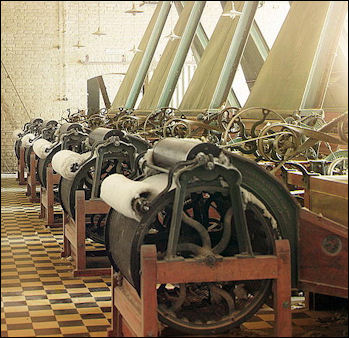
Cotton mill in Tashkent in 1905 The Industrial Revolution came about as an effort to devise faster ways to make cotton cloth and print it. One of the most important technological advances of that period was the water-powered spinning machine, which efficiently produced cotton thread for the first time. It was invented by Sir Richard Arkwright, a former barber who used fashion wigs from the hair he clipped from his clients, in the Derbyshire village of Cromford in 1771 and immediately put to work in a factory opened by Arkwright..
During the 18th century English women had taken a fancy to comfortable garments made from cloth woven in India. Arkwright and others realized that large profits could be made by growing cotton in the America and spinning it into thread and cloth in England. What is now the southern United States as selected because they were closer to Britain than India and had ideal climate for growing the crop.
In 1793 the cotton industry was given another boost when Eli Whitney invented the cotton gin, a hand cranked devise with a roller with teeth that tore the cotton into bits and removed the fluffy fibers (or lint) from seeds. By the mid 1800's America was exporting nearly two billion pounds of cotton a year. Most of it was being shipped into Liverpool and then transported by river and canal to Manchester for manufacturing. India did not become a major producer of cotton again until after the American Civil War stopped the supply of cotton to Britain from the United States. Egypt also later became a large supplier. **
Cotton, Colonialism and India
The classic example of imperialism (the acquisition of territory of one state by another to exploit their resources) involved cotton, India and Britain. Cotton grown in India was shipped to Manchester, England where it was made into finished goods which were sold back to India for a tidy profit. Gandhi began his home spinning movement and making of clothes to foil this trade. The British exploited Egypt in a similar way.
Cotton starting flowing out of India after the supply from the United States was cut off by the American Civil War. Cotton originated from South Asia. Cotton undergarments made in India in the 16th century were said be so delicate and beautifully embroidered they only lasted for a couple of hours. It was no surprise that Gandhi's first fast in 1918 was conducted to support textile workers in Ahmedabad striking for higher wages.
The factory in Ahmedabad where the men worked is still running today. "To drive the looms," wrote Jon Thompson in National Geographic,"huge wheels clattered and clanked, now run by electricity but powered by steam engines in the 19th century. Cotton dust had accumulated on the windows and on every pipe and loom and wire...Overhead pipes sprayed mist into the air to moisten the cotton fiber. The workers...wore only loin clothes...because of the unbearable heat and humidity...Although some of the workers were speaking , no sound came from their mouths. They were lip reading — some of them permanently deaf by the unrelenting noise." [Jon Thompson, National Geographic, June 1994]
Cotton Plant
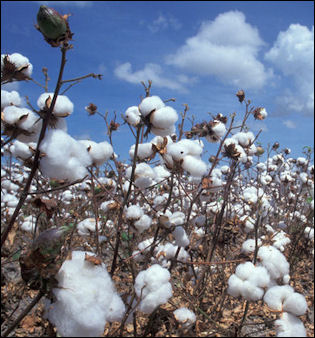
Cotton comes from the puffy, cotton fluff of seed pods that grow on plants that are a members of the mallow family. Cotton is ideal fore making thread and cloth because the flattened, twisted fibers that come from the seed pods interlock and bond when spun into string threads.
About two months after planting, when the plant is about a foot high, flowers develop from buds called “squares.” The flowers starts out white and then turn red on the second day after they appear. On the third day the petals fall off leaving behind undeveloped, flattened green pods called boll. .
The boll takes about 45 to 60 days to mature into an egg-shaped pod about an inch in diameters and an inch and a half long. Inside of each mature pod are three to five cotton-filled compartments call "locks." Each locks contains seven to ten seeds to which thousands of fluffy white cotton fibers are attached.
Cotton plants are weak. They are usually planted close together as a means of support. Only when they reach a height of six centimeters are growers confident that the plant won’t fail. After the plants are stronger and reach a height of ten centimeters they "chopped" to clear away weeds and excess plants. Some field have to "chopped" seven or times before the harvest.
Cotton Agriculture
Cotton needs lots of sun, a long hot summer and a fair amount of water to grow. It does well in dry climates and rich soils but does not do well in a climates that are too cold or too wet and requires 20 tons of water per day per acre (about the same amount of water as wheat) and needs a growing season of 200 frost-free days. Cotton depletes nutrients in the soil quickly and is often rotated with other crops. Because it needs a lot of sun and water it is often grown in hot, dry places with water supplied by irrigation. The average yield is around 600 pounds of cotton per acre.
Cotton-growing methods vary from region to region. In many developing countries the work is still done mainly by hand. The fields are plowed with horse or mules or some other animal and seeds are usually planted in rows at a depth of about one or two inches deep. In the developed world, cotton is grown in vast fields and is mechanically planted, cultivated and harvested. Fields are sprayed with fertilizers and pesticides with helicopters and planes.
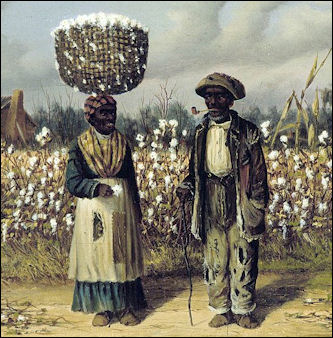
American cotton pickers
With cotton there is a strong risk of loss due to pest such as the boll weevil. Cotton has traditionally been grown with lots off fertilizers, pesticides and even defoliates (power Agent-Orange-like chemical that get rid of leaves and make it easier to pick cotton). Many of the problems that developed from DDT in the 1950s and 60s resulted from spraying huge amounts of it by plane on cotton crops.
Cotton is still picked by hand in many parts of the world. One reason for this is so the plants can be harvested several times as the bolls mature at different rates. Bolls on a single plant often ripen at different times. To speed up the ripening process sometimes farmers use chemical that defoliate the plant.
At harvest time the cotton plants are usually three to four feet high. Pickers wander through the fields with bags and pick the cotton either by "hand snapping" the entire boll, yielding cotton along with the husk and other stuff, or plucking the cotton from the boll. Skilled pickers can pick between 200 and 300 pounds of cotton a day. It is backbreaking work often done for little money. At the end of the day the hands of pickers are covered in cuts and scratches. Mechanical harvesting is done by two machines: a picker which pulls the bolls from the plant and stripper that slices the bolls and many of the leaves from the stalk.
Cotton Pests
Cotton is vulnerable to attacks by pests like boll weevils, a beetle with along nose-like appendage indigenous to the Gulf Coast area of Veracruz, Mexico where it has traditionally eaten a plant belonging to the cotton family called “Hampra” . These insects caused a great amount of destruction in the United States, arriving in Texas in 1894, spreading across much the American South by 1920and devastated that area until it the 1950s when it began to be successfully brought under control with insecticides such as DDT.
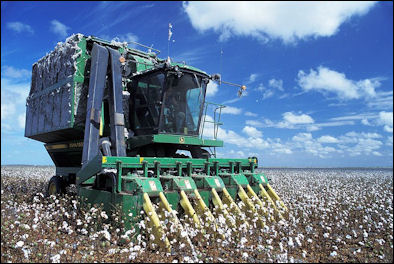
cotton harvest An early report of the insects destructive powers sent by a farmer from Texas to Washington read: “The ‘Top’ crop of cotton of this section has been very much damaged and in some cases almost entirely destroyed by a peculiar weevil or bug which by some means destroys the squares of the small bolls. Our farmer can combat the cotton worm but are at loss to know what to do to overcome this pest.”
With their long snout boll weevils pierce the flower buds or “squares” and eat the pollen inside. They also puncture the immature fruit of “bolls” and consume the developing cotton inside. But most destructively, the female drills deep inside the bolls and squares and deposits eggs. These hatch, releasing larvae that eat the plant’s reproductive structure, causing more damage to the squares and bolls. By the time they are finished a cotton field can be as much as 80 percent destroyed.
Boll weevils still cause around $150 million worth of damage a year in the United States but have largely been brought under control there thanks to traps bated with boll weevil pheromes and Malathion, a strong, effective chemical insecticide that has to be used sparingly because of the environmental damage it can cause. Using these tools it is hoped that the boll weevil will be eradicated completely from the United States by 2009. The boll weevil remains a threat in Mexico and Central America and is making advances in South America.. The cotton leafworm is another cotton pest that comes from the Veracruz area of Mexico.
Cotton Production
Cotton is regarded as an industrial crop. Modern mills are clean and have quiet machines. Some "virtually run themselves." Older factories found in places like India rely on machinery brought from England 100 years ago and are noisy, dirty, dangerous places filled inhalable dust and lint and mill laborers performing mind-numbing and body-destroying chores.
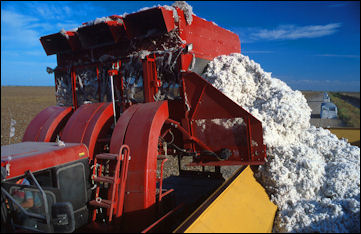
creating a cotton moduleThe first thing that is done after the cotton is harvested is the separation of the seeds from the cotton with a cotton gin consisting of hooked-tooth saws that tear the fibers from the seeds. Modern gins also remove moisture, impurities and dust from the fibers. Afterwards, the free fibers, called lint, are sucked away into a collection area. The seeds are saved to use for next year's crop or crushed to make oil for margarine, cooking oil or cosmetics. The cottons fibers are pressed into bales weighing around 500 pounds.
At a cotton mills picking machines clean the cotton and make it into rolls called “laps” . Carding machines, cylinders with wire points, straightens the fibers and mold them into finger-thick, ropelike strands called slivers. Drawing frames draw out several slivers at one time and combine them into single strands. Riving machines then twists and further draw out the cotton into a thinner strand. Spinning machine then draw and twist the strands into yarns of desired sizes and widens them on bobbins for weaving.
Yarns of cotton are woven together on looms with warps (lengthwise yarns) on rollers. Every other warp thread is lifted all at once while a shuttle drives wefts (crosswise yarn) under the even warp threads and over the odd ones. Rollers shift so that the weft carried by the shuttle on the return journey goes over the even warp threads and under the odd ones. The shuttle can make 200 or more trips a minute. Afterwards the unfinished "gray goods" fabric is taken to a converter for final processing. This includes bleaching, dying, preshrinking and printing the fabric. The fabric can be combed into denim and given a finishing of crepe, glazed chintze or water resistance.
Cotton Technology and Genetically-Modified Cotton
Recently scientist have cross white varieties of long-strand cotton with short-stranded colored cotton to produce colored cottons with fibers long enough for machine spinning. The advantage of these new varieties is that colored cotton doesn't fade like dyed cotton does, and polluting chemical dyes are not necessary. **
cotton module Biotechnology has produced disease-resistant cotton. Cotton bioengineered to withstand attacks from the cotton bollworm were introduced to north China around the year 2000. The cotton was engineered o produce a toxin — originally found in a soil bacterium called Bacillus thuringiensis — that was effective keeping the bollworm away and reducing the need for pesticide. [Source: Per Pinstrup-Andersen, Cornell University, Los Angeles Times]
Opponents of GM crops warned that the bollworms would develop resistance to the toxin and become more damaging than ever. That didn’t happen. Instead by eliminating the bollworms as a threat a new pest emerged — mirid bugs — that were not affected by the toxin and multiplied. Not only did they end up causing more damage than the bollworms they also devoured crops other than cotton such as grapes, apples, peaches and pears. Farmers handled the problem by using more pesticides than they did before the GM cotton was introduced.
Cotton farmers in Arizona faced the same dilemma after they began planting Bt cotton in 1996 and the absence of pesticides made fields safe for lygus bugs, a type of mirid bug. Farmers there dealt with the problem by using targeted pesticides that spared insects like ladybugs that feed on lygus bugs, said University of Arizona entomologist Bruce Tabashnik. [Source: Karen Kaplan, Los Angeles Times , May 16, 2010]
"The lesson here is that Bt cotton is not a silver bullet," said Tabashnik, who nonetheless endorses the crop for its role in reducing the need for anti-bollworm pesticides.There's no reason to think that other types of genetically engineered crops would be immune to this type of problem, Pinstrup-Andersen said. Ultimately, he said, the solution is to develop genetically modified plants that are resistant to a variety of insects, but that will be a continuous process. "We have to constantly stay ahead of those things," he said.
World’s Top Cotton Exporting and Importing Countries
loading a cotton module World’s Top Exporters of Cotton Lint (2020): 1) United States: 3822303 tonnes; 2) Brazil: 2125418 tonnes; 3) India: 965240 tonnes; 4) Greece: 289294 tonnes; 5) Benin: 280064 tonnes; 6) Australia: 170282 tonnes; 7) Burkina Faso: 166652 tonnes; 8) Argentina: 116881 tonnes; 9) Tajikistan: 100127 tonnes; 10) Uzbekistan: 100121 tonnes; 11) Sudan: 98205 tonnes; 12) Azerbaijan: 97578 tonnes; 13) Cote d’Ivoire: 91139 tonnes; 14) Turkey: 86899 tonnes; 15) Egypt: 75508 tonnes; 16) Tanzania: 69231 tonnes; 17) Kazakhstan: 62298 tonnes; 18) Malaysia: 54571 tonnes; 19) Afghanistan: 52279 tonnes; 20) Spain: 51730 tonnes [Source: FAOSTAT, Food and Agriculture Organization (U.N.), fao.org]
World’s Top Exporters (in value terms) of Cotton Lint (2020): 1) United States: US$5969433,000; 2) Brazil: US$3226916,000; 3) India: US$1448516,000; 4) Greece: US$449992,000; 5) Benin: US$448829,000; 6) Australia: US$307109,000; 7) Burkina Faso: US$263296,000; 8) Egypt: US$161604,000; 9) Turkey: US$159811,000; 10) Uzbekistan: US$147318,000; 11) Tajikistan: US$135994,000; 12) Azerbaijan: US$131930,000; 13) Cote d’Ivoire: US$124448,000; 14) Argentina: US$113673,000; 15) Sudan: US$110115,000; 16) Tanzania: US$97284,000; 17) Kazakhstan: US$82986,000; 18) Spain: US$80153,000; 19) Mexico: US$67266,000; 20) Togo: US$63288,000
World’s Top Importers of Cotton Lint (2020): 1) China: 2158095 tonnes; 2) Vietnam: 1388528 tonnes; 3) Bangladesh: 1190699 tonnes; 4) Turkey: 1064782 tonnes; 5) Pakistan: 818737 tonnes; 6) Indonesia: 486258 tonnes; 7) Egypt: 189917 tonnes; 8) India: 174121 tonnes; 9) Thailand: 133589 tonnes; 10) Malaysia: 121620 tonnes; 11) South Korea: 115204 tonnes; 12) Mexico: 95303 tonnes; 13) Iran: 77691 tonnes; 14) Taiwan: 67863 tonnes; 15) Japan: 34958 tonnes; 16) Peru: 34204 tonnes; 17) Portugal: 30001 tonnes; 18) Italy: 28379 tonnes; 19) El Salvador: 27904 tonnes; 20) Guatemala: 26844 tonnes [Source: FAOSTAT, Food and Agriculture Organization (U.N.), fao.org]
World’s Top Importers (in value terms) of Cotton Lint (2020): 1) China: US$3562312,000; 2) Vietnam: US$2176156,000; 3) Bangladesh: US$2014804,000; 4) Turkey: US$1652640,000; 5) Pakistan: US$1315549,000; 6) Indonesia: US$774649,000; 7) India: US$344649,000; 8) Thailand: US$218573,000; 9) Malaysia: US$209468,000; 10) South Korea: US$187109,000; 11) Egypt: US$168794,000; 12) Mexico: US$153431,000; 13) Iran: US$132042,000; 14) Taiwan: US$98787,000; 15) Peru: US$63999,000; 16) Japan: US$62533,000; 17) Italy: US$55981,000; 18) El Salvador: US$51221,000; 19) Portugal: US$48586,000; 20) Guatemala: US$45850,000
Exporters and Importers of Carded and Combed Cotton
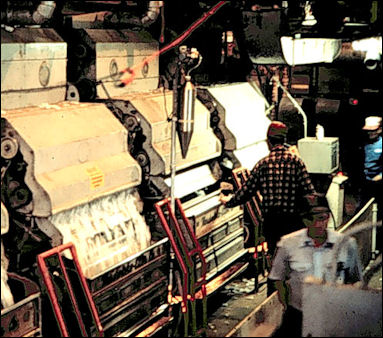
Cotton jins in use Combing and carding are two related techniques for preparing cotton, hair or wool fibres. With combing, fibres are passed through a series of straight, metal teeth in align the fibres parallel to one another so they can more easily be woven into yarn or fabric. Carding uses cards with numerous wire teeth that separate the fibres and spread them into a web (but not in parallel lines like with combed fires) and removes short or broken fibres as well as impurities. [Source: Leiden University]
World’s Top Exporters of Carded and Combed Cotton (2020): 1) Mali: 170000 tonnes; 2) India: 18499 tonnes; 3) Uganda: 17112 tonnes; 4) Indonesia: 13936 tonnes; 5) Mexico: 10227 tonnes; 6) United States: 8820 tonnes; 7) Turkey: 6165 tonnes; 8) Benin: 5991 tonnes; 9) South Korea: 5716 tonnes; 10) Mozambique: 4732 tonnes; 11) Poland: 3319 tonnes; 12) Lesotho: 2582 tonnes; 13) Vietnam: 2206 tonnes; 14) Japan: 1801 tonnes; 15) Portugal: 1317 tonnes; 16) Italy: 882 tonnes; 17) South Africa: 795 tonnes; 18) Netherlands: 653 tonnes; 19) Greece: 565 tonnes; 20) Bangladesh: 482 tonnes [Source: FAOSTAT, Food and Agriculture Organization (U.N.), fao.org]
World’s Top Exporters (in value terms) of Carded and Combed Cotton (2020): 1) Mali: US$433000,000; 2) United States: US$40954,000; 3) Uganda: US$23340,000; 4) Indonesia: US$20342,000; 5) India: US$16473,000; 6) Mexico: US$13025,000; 7) Benin: US$9639,000; 8) Poland: US$9523,000; 9) South Korea: US$9052,000; 10) Japan: US$7573,000; 11) Lesotho: US$6922,000; 12) Mozambique: US$6189,000; 13) Turkey: US$5050,000; 14) Netherlands: US$4276,000; 15) Italy: US$4161,000; 16) Vietnam: US$3972,000; 17) South Africa: US$2051,000; 18) France: US$1972,000; 19) United Arab Emirates: US$1657,000; 20) Belgium: US$1456,000
World’s Top Importers of Carded and Combed Cotton (2020): 1) Vietnam: 36588 tonnes; 2) Taiwan: 17637 tonnes; 3) Spain: 12868 tonnes; 4) Poland: 8945 tonnes; 5) United Kingdom: 7696 tonnes; 6) France: 7065 tonnes; 7) Russia: 6303 tonnes; 8) Bangladesh: 4406 tonnes; 9) South Africa: 2704 tonnes; 10) South Korea: 2613 tonnes; 11) Philippines: 2057 tonnes; 12) Japan: 1888 tonnes; 13) Mexico: 1473 tonnes; 14) Botswana: 1435 tonnes; 15) Malaysia: 1060 tonnes; 16) Honduras: 1053 tonnes; 17) China: 824 tonnes; 18) Italy: 743 tonnes; 19) Estonia: 720 tonnes; 20) Indonesia: 694 tonnes [Source: FAOSTAT, Food and Agriculture Organization (U.N.), fao.org]
World’s Top Importers (in value terms) of Carded and Combed Cotton (2020): 1) Vietnam: US$38816,000; 2) France: US$22985,000; 3) Taiwan: US$22638,000; 4) Poland: US$17744,000; 5) Spain: US$14327,000; 6) United Kingdom: US$12845,000; 7) Russia: US$11115,000; 8) Bangladesh: US$7682,000; 9) South Africa: US$6997,000; 10) Japan: US$6269,000; 11) Netherlands: US$5111,000; 12) Philippines: US$4969,000; 13) Honduras: US$4448,000; 14) Austria: US$3909,000; 15) Botswana: US$3837,000; 16) China: US$2930,000; 17) South Korea: US$2916,000; 18) Italy: US$2651,000; 19) Israel: US$2574,000; 20) New Zealand: US$2099,000
Edible Cotton
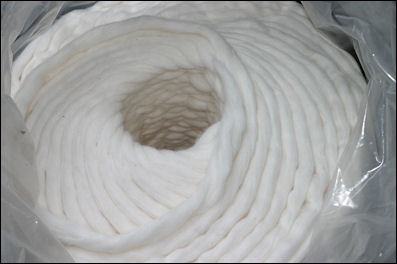
Cotton seeds contain a toxic chemical called gossypol, which helps protect the seeds from pests. If it wasn’t for that cotton seeds would be a good food. They are rich in high-quality protein. The plant grows well in hot, dry conditions.
Scientists at Texas A&M University lead by professor Keerti Rathore have managed to produce gossypol-free seeds in plants that have been engineered so that the gene responsible for producing gossypol does so in the leaves and flowers, protecting the plant from pests, but not in the seeds, allowing them to be eaten.
By one estimate 500 million people could get their protein needs from detoxified cottonseeds from current cotton-production levels. Under normal circumstances gosypil can only removed through an extensive refining process. The new genetically-engineered (GM) plants appear normal in every way except the gossypol is not present in the seeds and the traits can be passed on to offspring. Getting this kind of GM cotton approved will take some time. Additionally, in the early stages the seeds will be used mostly as animal feed. As for their taste, Rathore told Time magazine a he popped a few seeds in his mouth, “It’s not bad...like chick peas.”
Cottonseed Oil and Cake Producers and Exporters
World’s Top Exporters of Cottonseed (2020): 1) United States: 312428 tonnes; 2) Greece: 274137 tonnes; 3) Benin: 198645 tonnes; 4) Côte d'Ivoire: 160000 tonnes; 5) Brazil: 29313 tonnes; 6) Zambia: 18887 tonnes; 7) Togo: 16791 tonnes; 8) Kazakhstan: 15330 tonnes; 9) Azerbaijan: 13175 tonnes; 10) Ethiopia: 9491 tonnes; 11) Argentina: 8047 tonnes; 12) South Korea: 3884 tonnes; 13) Malawi: 3732 tonnes; 14) Nigeria: 3550 tonnes; 15) Turkey: 3289 tonnes; 16) Indonesia: 2877 tonnes; 17) Uzbekistan: 2062 tonnes; 18) Australia: 1736 tonnes; 19) Myanmar: 1185 tonnes; 20) Mexico: 1166 tonnes [Source: FAOSTAT, Food and Agriculture Organization (U.N.), fao.org]
World’s Top Exporters (in value terms) of Cottonseed (2020): 1) United States: US$94576,000; 2) Greece: US$69875,000; 3) Côte d'Ivoire: US$15800,000; 4) Benin: US$12491,000; 5) Ethiopia: US$9241,000; 6) Turkey: US$8320,000; 7) Brazil: US$6526,000; 8) Israel: US$4592,000; 9) India: US$3338,000; 10) Zambia: US$3209,000; 11) Togo: US$2814,000; 12) Azerbaijan: US$2523,000; 13) Nigeria: US$2520,000; 14) Kazakhstan: US$1539,000; 15) South Korea: US$1401,000; 16) Australia: US$1350,000; 17) Uganda: US$1304,000; 18) Netherlands: US$1133,000; 19) Argentina: US$1105,000; 20) France: US$796,000
World’s Top Producers of Cottonseed Oil (2019): 1) China: 1284700 tonnes; 2) India: 1199100 tonnes; 3) Pakistan: 323900 tonnes; 4) Brazil: 283801 tonnes; 5) United States: 218000 tonnes; 6) Turkey: 206500 tonnes; 7) Uzbekistan: 161570 tonnes; 8) Burkina Faso: 82071 tonnes; 9) Mali: 65300 tonnes; 10) Mexico: 64300 tonnes; 11) Turkmenistan: 45400 tonnes; 12) Benin: 35100 tonnes; 13) Cameroon: 29700 tonnes; 14) Myanmar: 26057 tonnes; 15) Egypt: 24400 tonnes; 16) Tanzania: 24100 tonnes; 17) South Korea: 24000 tonnes; 18) Greece: 22600 tonnes; 19) Kazakhstan: 20838 tonnes; 20) Italy: 20400 tonnes [Source: FAOSTAT, Food and Agriculture Organization (U.N.), fao.org]
World’s Top Exporters of Cottonseed Oil (2020): 1) United States: 33336 tonnes; 2) Uzbekistan: 22089 tonnes; 3) Kazakhstan: 12574 tonnes; 4) Turkey: 9032 tonnes; 5) Malaysia: 8972 tonnes; 6) South Africa: 7849 tonnes; 7) Azerbaijan: 6901 tonnes; 8) Brazil: 4706 tonnes; 9) Benin: 4510 tonnes; 10) Turkmenistan: 3500 tonnes; 11) Burkina Faso: 2567 tonnes; 12) China: 2199 tonnes; 13) Zambia: 2186 tonnes; 14) Greece: 579 tonnes; 15) Zimbabwe: 540 tonnes; 16) Egypt: 469 tonnes; 17) France: 437 tonnes; 18) Spain: 373 tonnes; 19) Germany: 269 tonnes; 20) Pakistan: 104 tonnes
cotton for sale in Luxor bazaar World’s Top Exporters (in value terms) of Cottonseed Oil (2020): 1) United States: US$30220,000; 2) Uzbekistan: US$16945,000; 3) Kazakhstan: US$11955,000; 4) Malaysia: US$10983,000; 5) South Africa: US$9402,000; 6) Turkey: US$8600,000; 7) Benin: US$4496,000; 8) Azerbaijan: US$4125,000; 9) Brazil: US$4077,000; 10) Turkmenistan: US$3200,000; 11) Zambia: US$2854,000; 12) China: US$2107,000; 13) Burkina Faso: US$1998,000; 14) Greece: US$755,000; 15) Spain: US$738,000; 16) France: US$603,000; 17) Germany: US$577,000; 18) Egypt: US$458,000; 19) Zimbabwe: US$401,000; 20) India: US$390,000
World’s Top Exporters of Cottonseed Cake (2020): 1) Benin: 106808 tonnes; 2) Greece: 87979 tonnes; 3) United States: 80106 tonnes; 4) Tanzania: 68042 tonnes; 5) Burkina Faso: 61455 tonnes; 6) Mali: 51369 tonnes; 7) India: 34489 tonnes; 8) Uzbekistan: 17506 tonnes; 9) Kazakhstan: 16918 tonnes; 10) Argentina: 16026 tonnes; 11) Azerbaijan: 14339 tonnes; 12) Zimbabwe: 9047 tonnes; 13) Zambia: 8727 tonnes; 14) Turkey: 6275 tonnes; 15) Uganda: 4510 tonnes; 16) Mozambique: 3895 tonnes; 17) Cote d’Ivoire: 2900 tonnes; 18) Indonesia: 2754 tonnes; 19) Turkmenistan: 1680 tonnes; 20) Iran: 1089 tonnes [Source: FAOSTAT, Food and Agriculture Organization (U.N.), fao.org]
World’s Top Exporters (in value terms) of Cottonseed Cake (2020): 1) Benin: US$30083,000; 2) United States: US$20573,000; 3) Greece: US$19773,000; 4) Tanzania: US$13076,000; 5) Mali: US$12830,000; 6) Burkina Faso: US$11017,000; 7) India: US$8377,000; 8) Uzbekistan: US$3657,000; 9) Kazakhstan: US$3218,000; 10) Zimbabwe: US$2881,000; 11) Argentina: US$2391,000; 12) Azerbaijan: US$2109,000; 13) Uganda: US$1767,000; 14) Zambia: US$1700,000; 15) Turkey: US$1314,000; 16) Mozambique: US$830,000; 17) Indonesia: US$782,000; 18) Turkmenistan: US$305,000; 19) Germany: US$284,000; 20) Austria: US$107,000
Image Sources: Wikimedia Commons
Text Sources: Mostly National Geographic articles. Also Time, Newsweek, New York Times, Washington Post, Los Angeles Times, Wikipedia, The Independent, Times of London, The New Yorker, Time, Newsweek, Reuters, AP, AFP, Lonely Planet Guides, Compton?s Encyclopedia and various books and other publications.
Last updated April 2022

